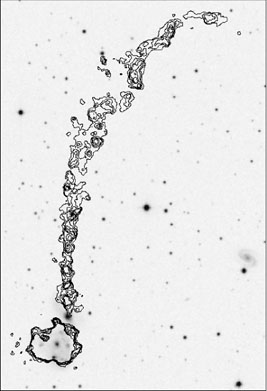


As the name implies, "tidal dwarf galaxies" are concentrations of stars entrained within tidal tails and believed to be gravitationally bound (Schweizer 1978). These systems have received considerable observational attention recently (e.g. Duc 1995, Hunsberger et al. 1996). However, because the inter-clump tidal material is so faint, H I mapping studies provide the only means of determining whether the local luminosity enhancements are kinematically distinct from the surrounding material, and this has only been done for a few systems (Hibbard et al. 1994; Hibbard & van Gorkom 1996; Duc et al. 1997).
Within tidal tails there is a wealth of substructure on many scales. It ranges from small, dense gaseous knots within purely gaseous features (e.g., Figure 4), to small luminosity enhancements within optical tidal tails (e.g. Hutchings 1996, Hunsberger et al. 1996), to dwarf-sized condensations of gas and stars fully embedded within a tidal tail (e.g. NGC 7252, NGC 3921 Hibbard & van Gorkom 1996; NGC 4038/9 Fig.1a); and finally to separate (and often separately classified) optical dwarfs entrained within mostly gaseous tidal features (e.g., M81 / NGC 3077, van der Hulst 1979; NGC 4027, Phookun et al. 1992; NGC 520 / UGC 957, Hibbard & van Gorkom 1996; Arp 105, Duc et al. 1997; NGC 5291, Malphrus et al. 1997). An outstanding question is whether there is an evolutionary link between any/all of these categories of structures.
 |
Figure 4. VLA B+C+D-array observations of the Ring Galaxy Arp 143 Higdon & Appleton, in preparation; see also Appleton et al. 1987). This purely gaseous tidal tail contains a wealth of structure on 5" scales, with peaks up to 1021 cm-2. The present observations do not have the velocity resolution to address whether individual clumps are self gravitating. |